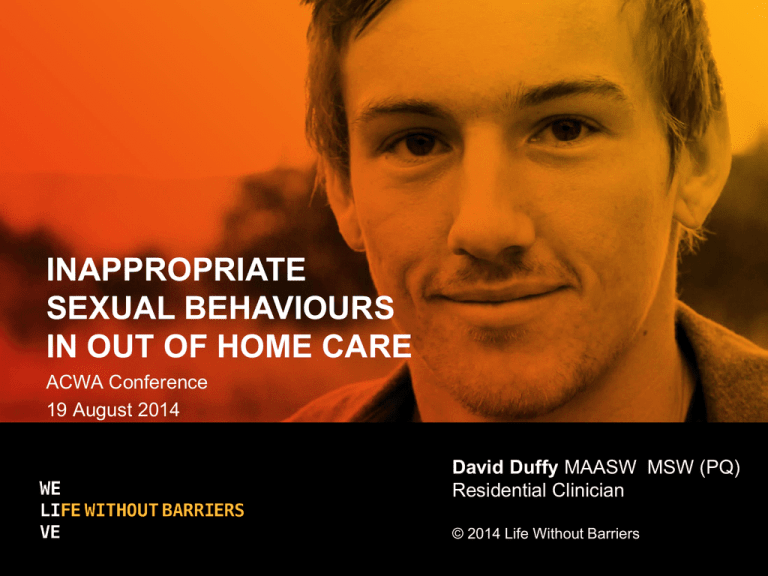Duffy
advertisement

INAPPROPRIATE SEXUAL BEHAVIOURS IN OUT OF HOME CARE ACWA Conference 19 August 2014 David Duffy MAASW MSW (PQ) Residential Clinician © 2014 Life Without Barriers Role of Life Without Barriers Life Without Barriers’ family support and out-of-home care services include: • Foster care • Residential care • Supported accommodation • Family contact • Case management • Education • Clinical services • Cultural planning • Family support • Transition support • Respite Sexual Development • Sexual behaviours begin to emerge in infancy • Overt behaviours peak between the ages of two and six • Overt behaviours decline with age and re-emerge in adolescence • Sexual development is an individualised process. (Friedrich, 1997; Friedrich, 1998; Tarren-Sweeney, 2008). Inappropriate Sexual Behaviour Inappropriate sexual behaviour on the part of a child or young person includes, but is not limited to, sexual behaviour or activity that: • places the person at risk • places others at risk • causes offence • or impacts on the person’s social and community inclusion. Complexity • Young people in out of home care typically have complex maltreatment histories (complex trauma) • Young people in Out of Home Care have a high rate of sexual behaviour problems, especially children and youth in residential care • It may lead to more serious behaviour • Extreme reactions from carers and others Consequences Placement breakdown Legal system involvement School disruption Disrupted attachment Sexual exploitation Re-traumatisation Carer/family/peer stress and rejection Challenges • Lack of Australian research • No single definition of inappropriate sexual behaviour • Misconceptions about inappropriate sexual behaviour • Secretive nature of some sexual behaviour • The need for non-stigmatising responses • Few specialist services in regional and remote areas TRAINING PROGRAM Training Overview • Target population: Carers of children 12-17 years of age with inappropriate sexual behaviours • Training parameters: 2 x 3 hour workshops and a participant workbook • Homework (optional): Homework is used to help reinforce the practices supportive of effective use • Resources required: This program is implemented into an existing therapeutic environment that will have individual offices, group rooms, and administrative assistance • Recommended provider qualifications: Bachelor’s degree with 2 years appropriate clinical experience in a relevant field Training Goals • Provide carers a practice framework • Prevent, eliminate or reduce the behaviours • Enhance documentation and timely communication • Build attachment relationships • Reduce carer stress and reactivity • Increase carer understanding and behaviour support skills • Increase collaboration and consistency in response from carers, young people and needed services. Theoretical Foundation • Adolescent development (Rich, Steinberg & Scott; Zimring) • Childhood sexuality (Fredrich, Ryan) • Trauma (Briere, Herman, Perry) • Attachment (Bowlby, Fredrich, Rich, Schore) • Psychoeducation groups (Dixon, Marsh, Brown) • Functional analysis and positive behaviour supports (Horner & Sugai, LaVigna & Willis). Training Modules Knowledge Skills • • • • • • • • • Adolescent development Development of sexual behaviours Inappropriate sexual behaviours Sexual behaviours and the law Young people living in OOHC Risk factors Cultural considerations Carer reactions Consequences • Information gathering • Making sense of the behaviour • Support strategies How do we decide whether the behaviour is inappropriate? Age appropriate sexual behaviours Concerning sexual behaviours Very concerning sexual behaviours (Ryan and Blum, 1994) Information Gathering • Sources of information • Requesting further information • Collecting behavioural observations Making sense of the Behaviour • While the behaviour may appear overtly sexual in nature, the motivation for the behaviour may not be sexual at all. • Silovsky and Bonner (2003) argued that the behaviours may be related to natural curiosity, anxiety, imitation, attention-seeking, or self-calming. Domains Safety Stability Wellbeing How we can increase safety? • Monitoring • Documentation and communication • Reporting risk of significant harm How we can increase stability? • Psychoeducation • Relationship building • Self Care How we can increase wellbeing? • Behaviour support • Referral to specialist supports Putting it all together Training Outcomes Where to next Sub copy to go here • Continue evaluation • Training of trainers • Roll out across other sites • Systems to maintain skills • Establish reference group • Increase carer access • Widen target group. 22 Contact Details • David Duffy MAASW MSW (PQ) Residential Clinician Life Without Barriers • Email: david.duffy@lwb.org.au • Phone: 02 6690 3500









